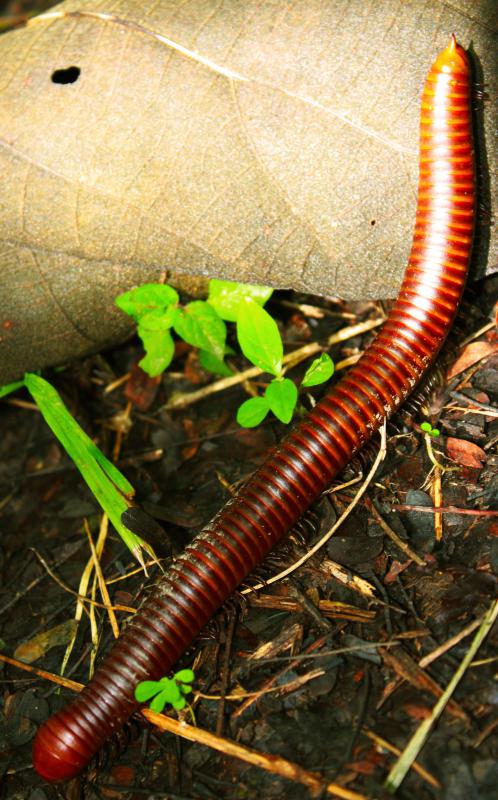At AllThingsNature, we're committed to delivering accurate, trustworthy information. Our expert-authored content is rigorously fact-checked and sourced from credible authorities. Discover how we uphold the highest standards in providing you with reliable knowledge.
What is the Bog Turtle?
The bog turtle (Glyptemys muhlenbergii) holds the distinction of being the smallest turtle in North America. An adult typically is 4 inches (10 centimeters) long and tips the scales at 4 ounces (110 grams). Located mostly along the Atlantic seaboard in the United States, the reptile has a life span of more than 40 years and lives in wet areas including bogs, marshes, swamps, and streams. Development of its habitat has diminished the turtle’s population and the animal is protected by the Endangered Species Act.
Mostly dark in color, the bog turtle is known for the distinct markings along its neck. Near the eye and on the side of its head, the turtle possesses a vividly colored spot. Blotches may be orange, yellow, or red, or a combination of colors. The colored markings become brighter as the bog turtle ages.

Bog turtles can be found in the Northeast United States, in Massachusetts, Connecticut, Delaware, New York, New Jersey, Rhode Island, and Pennsylvania. To the south, colonies of the turtles reside in Maryland, Georgia, North Carolina, South Carolina, Tennessee, and Virginia. In its habitat, the omnivorous creature feeds on insects including crickets, beetles, and millipedes. The turtle's diet also may include some plants such as skunk cabbage and duck weed. In addition, the turtle may eat frogs, tadpoles, snails, salamanders, crayfish, and nestling birds.

Being a cold-blooded animal, the turtle is more active during the day, particularly early in the morning or in the late afternoon. During the warm summer months, during the hottest part of the day, the turtles may seek cover in a burrow or at the bottom of shallow water. During the winter months, they hibernate in underwater bogs that may be up to 18 inches (around 45 centimeters) deep. Oftentimes bog turtles will hibernate as a group — even with other species of turtles.

Predators of the bog turtle include foxes, raccoons, water snakes, dogs, muskrats, and large birds. To protect itself, the turtle may hide itself in mud. Turtles are also illegally hunted as pets. Other threats to the turtle include the draining and filling of the creatures' wetland habitat.
By the time they are 8 years old, bog turtles are usually sexually mature and generally in early spring after hibernation, the turtles will mate. A male usually tries to find a mate by nudging or nipping at a female. A female will lay up to five small white eggs in sunny spots. Eggs may take up to two months to hatch. When born, turtles measure about 1 inch (2.4 centimeters) long.
Frequently Asked Questions
What is a bog turtle and where can it be found?
The bog turtle is a small, semi-aquatic turtle species known for its distinctive orange patches on either side of its head. It inhabits wetland areas in the eastern United States, with a range extending from New York to Georgia. These turtles prefer the spongy, muddy environments of bogs, fens, and marshes, where they can find ample vegetation and prey.
How big do bog turtles get?
Bog turtles are among the smallest turtles in North America, reaching only about 4.5 inches in length when fully grown. Their diminutive size contributes to their vulnerability, as they can easily fall prey to predators and face challenges due to habitat loss and fragmentation.
What do bog turtles eat?
Bog turtles are omnivores with a varied diet that includes insects, snails, worms, and other invertebrates, as well as some plant material. They forage in the soft mud of their wetland habitats, using their sharp beaks to capture and consume their prey.
Why are bog turtles endangered?
Bog turtles are classified as critically endangered due to a combination of factors. Habitat destruction, illegal poaching for the pet trade, and invasive plant species are significant threats. According to the U.S. Fish and Wildlife Service, conservation efforts are crucial to protect the remaining populations and their habitats.
What is being done to protect bog turtles?
Conservation initiatives for bog turtles include habitat restoration, protection of wetlands through legislation, and captive breeding programs. Organizations collaborate to monitor populations, manage invasive species, and raise public awareness. These efforts aim to stabilize and increase bog turtle numbers and preserve their natural environments.
Can I keep a bog turtle as a pet?
Keeping a bog turtle as a pet is strongly discouraged and often illegal due to their endangered status. Removing bog turtles from the wild can further threaten their populations. Instead, those interested in helping can support conservation programs or consider volunteering with local wildlife rehabilitation centers that work with native species.
AS FEATURED ON:
AS FEATURED ON:













Discuss this Article
Post your comments